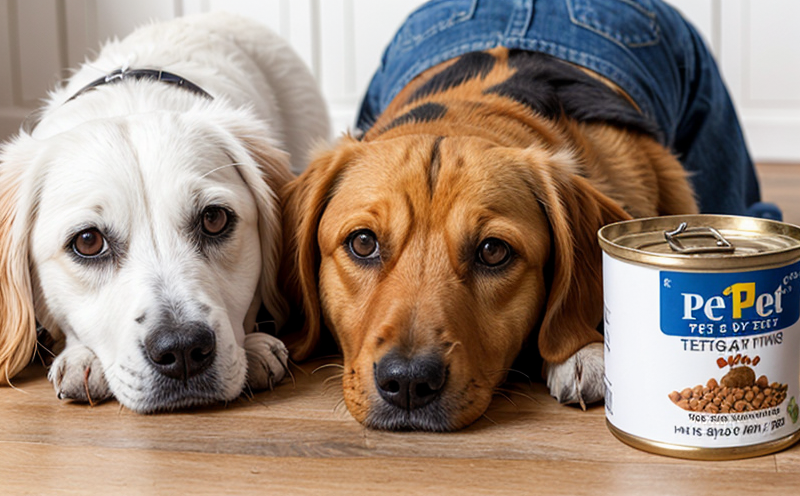ISO 6496 Moisture Content Testing in Pet Kibble
The moisture content of pet food is a critical parameter that significantly impacts its nutritional value, shelf life, and safety. ISO 6496 provides a standardized method for determining the moisture content of pet kibble, ensuring uniformity across different manufacturing processes and brands.
This test is essential for quality control in pet food production as it helps ensure consistent product quality and meets consumer expectations regarding freshness and shelf life. Moisture levels directly affect the stability of nutrients, mold growth potential, and palatability of the pet kibble. Excessive moisture can lead to spoilage, while insufficient moisture may result in poor texture or reduced digestibility.
The procedure involves drying a sample of pet kibble at a specific temperature (typically 105 ± 2°C) until constant weight is achieved. This ensures that all volatile components, including water, have been removed without affecting the non-volatile components like fats and proteins. After drying, the mass loss is calculated as a percentage of the original sample weight to determine moisture content.
Accurate moisture content testing not only contributes to maintaining product quality but also ensures compliance with international standards such as ISO 6496. This standardization is particularly important in an industry where pet food products are exported globally, requiring uniformity and reliability across different markets.
For R&D engineers, this test provides insights into the optimal moisture levels for enhancing palatability and digestibility while minimizing spoilage risks. For quality managers, it ensures that production processes meet strict quality standards, thereby protecting brand reputation and consumer trust. Compliance officers benefit from accurate testing to avoid potential legal issues related to product safety and labeling.
Why It Matters
The moisture content in pet kibble plays a pivotal role in determining the overall quality of the product. Moisture levels can influence several key factors:
- Nutritional Value: Excessive moisture can lead to nutrient degradation, reducing the nutritional value of the food.
- Shelf Life: Higher moisture content accelerates spoilage and mold growth, shortening the product's shelf life.
- Digestibility: Optimal moisture levels enhance palatability and improve digestibility for pets.
- Palatability: Proper moisture ensures that the kibble remains crisp and appealing to pets.
In addition, compliance with ISO 6496 ensures that pet food manufacturers can market their products confidently in international markets. This standardization is crucial for maintaining a high level of trust among consumers who rely on consistent product quality.
For procurement teams, accurate moisture content testing helps them identify reliable suppliers and ensure the consistency of raw materials across different batches.
Quality and Reliability Assurance
Ensuring that pet kibble meets rigorous quality standards is paramount for maintaining consumer trust and satisfaction. By adhering to ISO 6496, laboratories can provide reliable moisture content data that supports various aspects of the product lifecycle:
- R&D and Development: Testing helps in optimizing formulations to meet specific nutritional requirements.
- Manufacturing: Consistent moisture levels ensure uniformity in production batches, enhancing overall quality control.
- Storage and Distribution: Proper moisture management reduces the risk of spoilage during storage and distribution, extending shelf life.
- Sales and Marketing: Accurate testing supports effective marketing strategies by highlighting product quality and safety.
The reliability of ISO 6496 moisture content testing is further enhanced through advanced instrumentation and techniques such as gravimetric analysis. This ensures that the results are precise, repeatable, and compliant with international standards. Laboratories can thus provide robust data to support regulatory compliance and consumer confidence.
International Acceptance and Recognition
- United States: ISO 6496 is widely accepted in the U.S., aligning with FDA regulations for pet food safety and quality.
- European Union: The standard is recognized across EU countries, ensuring that pet food manufacturers comply with European standards.
- United Kingdom: ISO 6496 is fully recognized in the UK, supporting both domestic and international trade.
- Australia and New Zealand: The standard is accepted in these markets, facilitating exports to Oceania.
- Japan: While not directly referenced, the principles of ISO 6496 align with Japanese food safety standards.
The acceptance and recognition of this standard across multiple regions underscore its importance in ensuring consistent moisture content testing practices. This uniformity is critical for maintaining high-quality pet food products that meet global consumer expectations and regulatory requirements.





